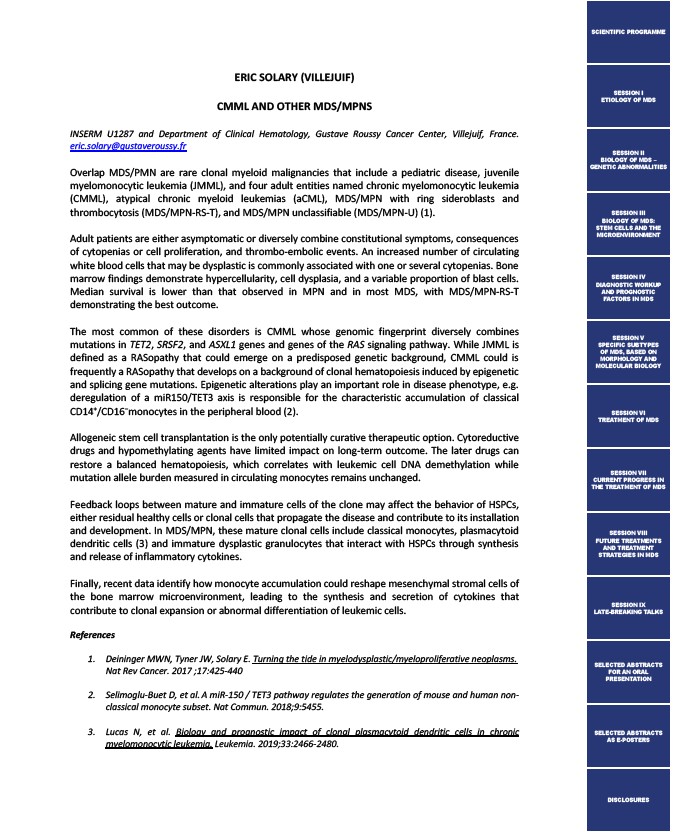
ERIC SOLARY (VILLEJUIF)
CMML AND OTHER MDS/MPNS
INSERM U1287 and Department of Clinical Hematology, Gustave Roussy Cancer Center, Villejuif, France.
eric.solary@gustaveroussy.fr
Overlap MDS/PMN are rare clonal myeloid malignancies that include a pediatric disease, juvenile
myelomonocytic leukemia (JMML), and four adult entities named chronic myelomonocytic leukemia
(CMML), atypical chronic myeloid leukemias (aCML), MDS/MPN with ring sideroblasts and
thrombocytosis (MDS/MPN-RS-T), and MDS/MPN unclassifiable (MDS/MPN-U) (1).
Adult patients are either asymptomatic or diversely combine constitutional symptoms, consequences
of cytopenias or cell proliferation, and thrombo-embolic events. An increased number of circulating
white blood cells that may be dysplastic is commonly associated with one or several cytopenias. Bone
marrow findings demonstrate hypercellularity, cell dysplasia, and a variable proportion of blast cells.
Median survival is lower than that observed in MPN and in most MDS, with MDS/MPN-RS-T
demonstrating the best outcome.
The most common of these disorders is CMML whose genomic fingerprint diversely combines
mutations in TET2, SRSF2, and ASXL1 genes and genes of the RAS signaling pathway. While JMML is
defined as a RASopathy that could emerge on a predisposed genetic background, CMML could is
frequently a RASopathy that develops on a background of clonal hematopoiesis induced by epigenetic
and splicing gene mutations. Epigenetic alterations play an important role in disease phenotype, e.g.
deregulation of a miR150/TET3 axis is responsible for the characteristic accumulation of classical
CD14+/CD16−monocytes in the peripheral blood (2).
Allogeneic stem cell transplantation is the only potentially curative therapeutic option. Cytoreductive
drugs and hypomethylating agents have limited impact on long-term outcome. The later drugs can
restore a balanced hematopoiesis, which correlates with leukemic cell DNA demethylation while
mutation allele burden measured in circulating monocytes remains unchanged.
Feedback loops between mature and immature cells of the clone may affect the behavior of HSPCs,
either residual healthy cells or clonal cells that propagate the disease and contribute to its installation
and development. In MDS/MPN, these mature clonal cells include classical monocytes, plasmacytoid
dendritic cells (3) and immature dysplastic granulocytes that interact with HSPCs through synthesis
and release of inflammatory cytokines.
Finally, recent data identify how monocyte accumulation could reshape mesenchymal stromal cells of
the bone marrow microenvironment, leading to the synthesis and secretion of cytokines that
contribute to clonal expansion or abnormal differentiation of leukemic cells.
References
1. Deininger MWN, Tyner JW, Solary E. Turning the tide in myelodysplastic/myeloproliferative neoplasms.
Nat Rev Cancer. 2017 ;17:425-440
2. Selimoglu-Buet D, et al. A miR-150 / TET3 pathway regulates the generation of mouse and human non-classical
monocyte subset. Nat Commun. 2018;9:5455.
3. Lucas N, et al. Biology and prognostic impact of clonal plasmacytoid dendritic cells in chronic
myelomonocytic leukemia. Leukemia. 2019;33:2466-2480.
SCIENTIFIC PROGRAMME
SESSION I
ETIOLOGY OF MDS
SESSION II
BIOLOGY OF MDS –
GENETIC ABNORMALITIES
SESSION III
BIOLOGY OF MDS:
STEM CELLS AND THE
MICROENVIRONMENT
SESSION IV
DIAGNOSTIC WORKUP
AND PROGNOSTIC
FACTORS IN MDS
SESSION V
SPECIFIC SUBTYPES
OF MDS, BASED ON
MORPHOLOGY AND
MOLECULAR BIOLOGY
SESSION VI
TREATMENT OF MDS
SESSION VII
CURRENT PROGRESS IN
THE TREATMENT OF MDS
SESSION VIII
FUTURE TREATMENTS
AND TREATMENT
STRATEGIES IN MDS
SESSION IX
LATE-BREAKING TALKS
SELECTED ABSTRACTS
FOR AN ORAL
PRESENTATION
SELECTED ABSTRACTS
AS E-POSTERS
DISCLOSURES